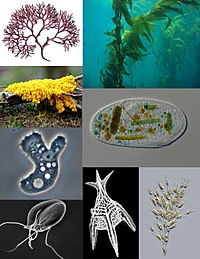
Photo from wikipedia
Diatoms have recently emerged as new promising sources of fucoxanthin and eicosapentaenoic acid (EPA). Most applied studies in this area have focused on marine diatoms whereas the characterization of freshwater… Click to show full abstract
Diatoms have recently emerged as new promising sources of fucoxanthin and eicosapentaenoic acid (EPA). Most applied studies in this area have focused on marine diatoms whereas the characterization of freshwater diatom metabolism has been restricted to ecophysiological studies. Here, we describe a novel culture medium for freshwater diatoms, the FDMed medium, and we demonstrate that it supports high biomass, fucoxanthin, and EPA production yields in photoautotrophic batch cultures of Sellaphora minima and Nitzschia palea . Growth was monitored for 21 days, fucoxanthin and EPA concentrations were assayed all along cultivation processes, and results were compared to those obtained for two other media (WC and Modified COMBO (MCOMBO)). The FDMed medium was found to increase biomass yields comparatively to MCOMBO medium (5–7-fold higher algal concentration at the stationary phase in S. minima and N. palea , respectively) while WC medium enables nearly no growth. The evolution of nitrate, silicate, and phosphate concentrations in culture media indicated a much better balance of macroelements in the FDMed medium. Fucoxanthin contents within the biomass remained very stable in the FDMed medium compared to the other media, in which it gradually decreases, and the best results (around 7.5 mg g -1 dry weight ) were obtained for S. minima in the FDMed medium. EPA could only be measured in the FDMed medium and the highest content (14.0 mg EPA g -1 dry weight) was recorded in N. palea . This work demonstrates the great industrial potential of freshwater diatoms and provides an efficient culture medium for those organisms.
Journal Title: Journal of Applied Phycology
Year Published: 2020
Link to full text (if available)
Share on Social Media: Sign Up to like & get
recommendations!